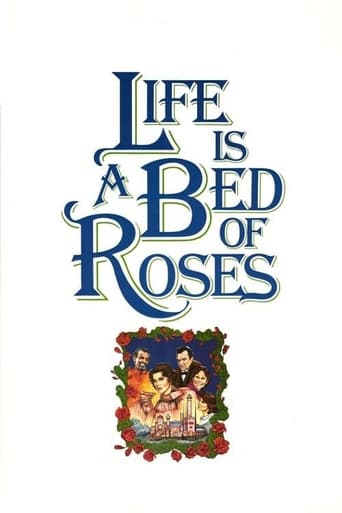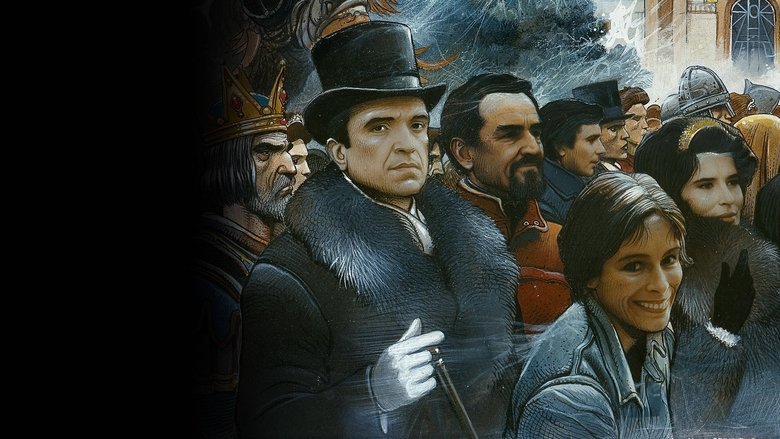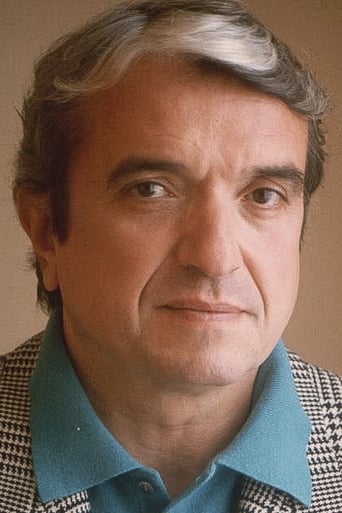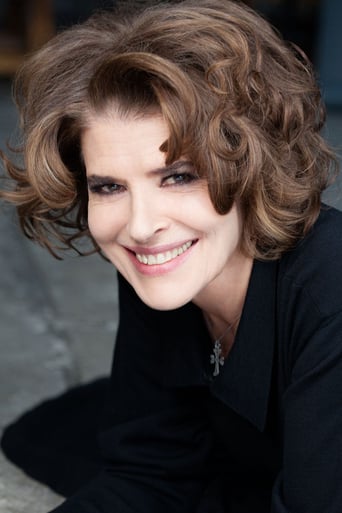

Life Is a Bed of Roses (1983)
In this whimsical fable, Resnais deftly interweaves three story lines: the creation of an early-20th-century utopia; romantic high jinks at a school conference; and a fantasy sparked by F/X pioneer Georges Méliès.
Watch Trailer
Cast


Reviews
This was a resounding flop when it came out, both in France and abroad. It's still not appreciated even among fans of Resnais who have come to terms with his lighter side. It's not hard to see why. Coming from the man who gave us Marienbad, this seems like a small narrative essay packed inside of lightweight fantasy in the Woody Allen mode. A matter of silly adolescent frolicking instead of deep mysterious passion.Fair point. But here's something else.Resnais broadly speaking loves two things. On one hand theater, movies, architecture, comic-books (he is an avid collector) - so by extension, the color, frill and artifice of appearance. And you can see that in his actual films, almost without exception tuned to musing, fabrication and some form of theatricality.His primary interest, however, is extending this notion of constructed realities to the deep end of the architecture of self. In simple terms, he attempts to show that what we largely accept as abstract propositions about ourselves (thought, memory) are internally the same fabrication as anything we build in life, governed by exactly the same mechanism.Cinema is the best medium to inherit the endeavor - not only is every image (as is every thought) staged in the mind's eye, not only does the camera as internal narrator shuffle and slide through successive planes of narrative, but external space (the library in Tout le Histoire, the museum in Hiroshima, the hotel in Marienbad, the capsule in Je t'aime, etc.) mirrors our experience of internal space, the faculties of consciousness.Add to these the lavish château somewhere in the Ardennes of this film.There are three overlapping narratives centered on that place. One is romantic myth about the baby son of a king who grows up to slay the dragon and rescue the maiden. The second is about an architect in the 1910's whose plans to build the château and marry his loved one are interrupted by WWI. The third is set in present times, about a conference of intellectuals who convene there to discuss new educational (narrative) principles.The main narrative thrust across all three is that there is no harmony in the workings of the soul, though we construct artifice to that effect. There is a dialogue of sorts this kicks off within the film. Look at what Resnais does.All three narratives centered on artifice and ritual. Myth, glassy theatric decor, operatic singing in the first. Miniature model, actual building and ritualized experiment that later takes place there in the second. Another miniature landscape, the conference and romantic plot (which is not spontaneous but manipulated by a third party, artificial) in the third.And the point repeated across all three is what? But of course the forcible attempt to create harmony, which is to say forcing nature to conform to what the mind thinks it ought to be.Of the three, only the myth is happily resolved, the obvious product of fabrication. The architect conducts an experiment that supposedly is going to make everyone happy and in harmony with the world, but all the guests drink the miraculous potion except the love of his life; love cannot be manipulated to happen.The conference erupts in violent disagreement over the preferred educational method. The romantic thrysts end in unpredictable notes, not at all according to the plan of the woman who has manipulated the plot - played by Geraldine Chaplin, whose father made his cinematic fortunes by peddling artificial harmony and miraculous love.The point is that there is no harmony outside the stories we devise to attempt it, no single method to navigate the landscape of life. Being interested, alert, spontaneous and involved in its exploration, like the teacher is interested in the miniature landscape laid before the educators, is the only way.This is good stuff, folks, showing wisdom. It will not immediately win you over, because it's not a rich swim like early Resnais or Tarkovsky. It is whimsical, but not in the confrontational way of Greenaway, a bit chaste. The eye does not move walls of perception around, as in Welles. Unlike Inception, it explains in light ripples. So be it. I count it next to Draughtsman as among the most intelligent in film.
I saw Life is a Bed of Roses as an admirer of Ruggero Raimondi, and I do think it is not going to please everybody with a sometimes sluggish pace, the choral interruptions sometimes infuriating and while the three part structure to be interesting with some great ideas introduced the story can lack coherency with some ideas coming across as half-baked and people may find it difficult to get into. However, it is filmed very handsomely with the set and costume design beautifully rendered especially in the last tale. The score is wonderful, giddy and haunting, I loved the theme of the perfectibility of human existence. Of the three tales I found the Forbek tale to be the most well-done with the firmest ending and a genuine sense of drama. The last story was great in idea but never satisfactorily explored, apart from Robert's relationship with his son, everything else seemed underdeveloped and clichéd. I also admire Resnis' ambition, this is clearly an ambitious film and is well-intended, but the execution didn't quite come together. The characters are deliberately kept at distance, and while most are not very easy to empathise with, I did think Robert and Forbek were well-realised. The acting is good though, Ruggero Raimondi always was a fine actor even in the operatic roles like Don Giovanni and Scarpia that he was famous for, and I think he was a big reason why the first tale was believable. Fanny Ardent and Geraldine Chaplin play their roles with ardour, Ardent in particular is incredibly radiant. and Vittorio Gassman is a good Walter. As for Pierre Arditi he does appear obnoxious at first, but plays his role also with pathos. Overall, an uneven film but quite interesting. 6/10 Bethany Cox
Alain Resnais directs three parallel stories that have to do with fantasy and imagination in the adult world. In one of them is a sort of Operatic bordello story where a rejected architect attempts to manipulate a group of people into throes of happiness--only his attempt misses it's only real target, the woman that he pines after. In the same unfinished château he built, a group of teachers search for love in a more modern story, as one woman believes ineffably in the role of romance and the cynical anthropoligist tries to teach her a lesson by setting her up with the biggest jerk in the group. Meanwhile, a bunch of kids fantasize a George Melies-like adventure of a prince that saves a girl in distress from swamp creatures and then kills the evil king, bringing upon the kingdom of love. The two primary themes? Life is a fairy tale, and Life isn't a fairy tale.Which sounds better than the movie actually is. Resnais is the type of director where oftentimes the concept is good or bad, but the exposition is what matters; here, the concept is great but the movie is downright painful to watch. Horridly off-tune songs, bubbly characters without an ounce of dimension, backdrops of sickening pastel--instead of giving your inner child an ice cream cone, Resnais drowns it in a bucket of cake frosting. Add some French philosophy and you get a weird witches brew, one that doesn't bubble bubble toil and trouble, but just kinda sits wrong in your stomach until you want to regurgitate it.Resnais is a risk-taking director, and even in his worst you can see he's trying something that might not work with full clarity of action. In I Want to Go Home, he manages to pull past annoying characters and ditzy set-pieces by showing some real change and having a moment few moments of quiet to catch his breath. Here he submerges directly into a fantasy that doesn't really reflect fantasy, only its baby's room wallpaper reference. The biggest problem is that he somehow managed to make a movie more flamboyant than an 80s pop video, and more kitsch than Golden Era Hollywood musicals. The fantasies are beyond childish and naive, but the movie (with nudity and profanity) is definitely aimed for adults, a target he decidedly missed.However, he sticks closely to his theme and never backpedals. If anything, this movie is impressive simply because its unapologetic.--PolarisDiB
Watching the first few moments, you realize it's going to be a parody - and certainly it *is* a parody, but I'm not sure of what (a fairy tale? an opera? a Hollywoodian C-movie? - if there was something like that), and I can assure you it's not worth watching. It's simply a pointless film (cf. a good parody is everything but pointless), with pretentious, shallow speeches of extremely sketchy characters. It's like a commedia dell'arte. Or better, it's like a botched commedia dell'arte. And the score... sung in an intentionally incompetent way (something Greenaway will use much more efficiently), it *is* painful to listen to (unless one wears some sate-of-the-art earplugs, haha). Go for quality movies (e.g. A. Mitta's How Czar Peter the Great Married Off His Moor, 1976) and steer clear of this mistake.




